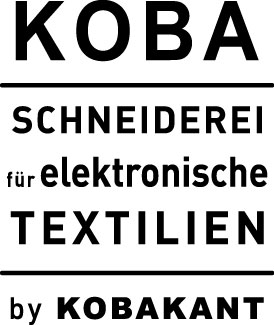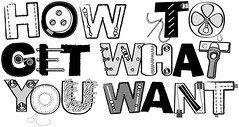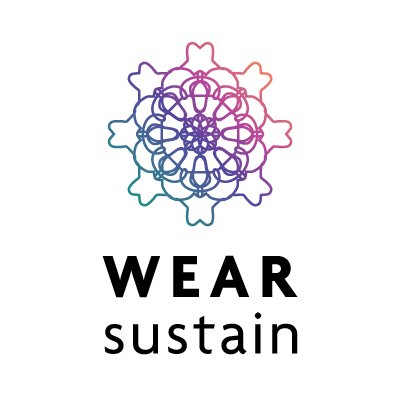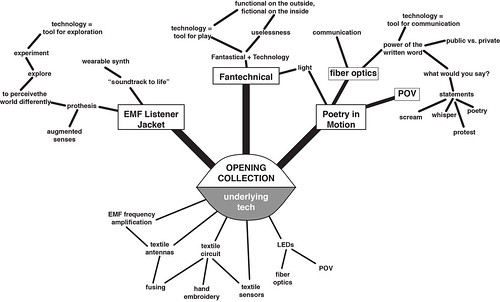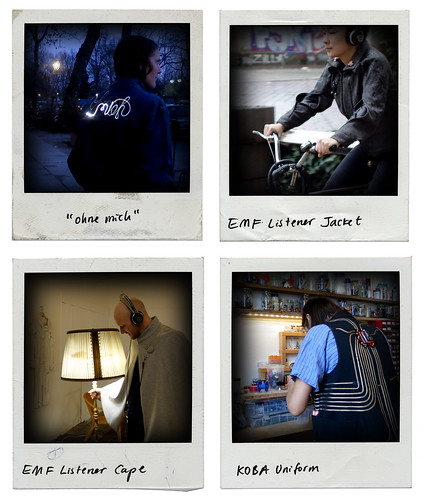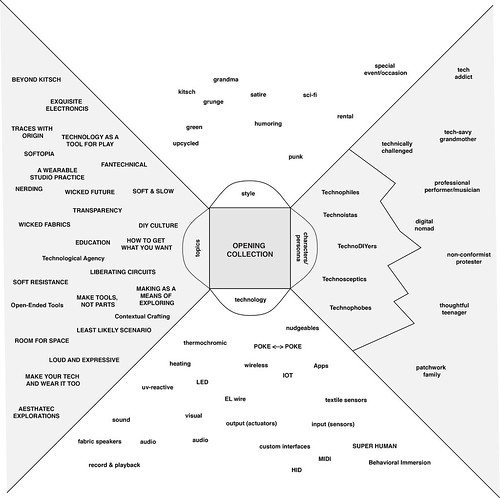Our Opening Collection
So what will the items in this collection be??????? We’ve been discussing this question for over a week now, which has caused us to question our underlying motivations over and over again.
In a recent post titled “Fake Commissions for Inspiration” we explained our reasons for having an “Opening Collection”:
– to demonstrate what is technically and conceptually possible
– to express our aesthetic style and twisted/humorous take on technology
– to get people thinking outside the box
We listed three ideas/approaches for helping people think outside the box: TIME MACHINE, FAKE COMMISSIONS, SOMETHING USEFUL p-l-u-s SOMETHING ELSE.
Bellow we introduce the four items we’ve chosen for our Opening Collection. And further down you can read a bit more about what went on “Behind the Scenes” of developing this collection. The descriptions of these collection items are still quite fresh, and we are still developing them, so things will still change.
The illustration above is SUPER rough and not to be taken too seriously. We plan to update it in future posts.
KOBA Opening Collection
Poetry in Motion
“All your pixels are belong to me”
Written language is powerful tool for private communication as well as public propaganda. How would you feel about displaying words that hold meaning on your body? Would you write your own words? Would you select from your favorite song lyrics? Would you ask somebody to compose a poem for you to wear?
Would you choose powerful words that scream ideology/manifesto. Would you use poetic language to express something you want others to understand. Would you become a platform for the public to voice their opinions?
As long as word combinations are infinite, the options are limitless…
Inspirations/References:
Jenny Holzer: http://projects.jennyholzer.com/
Bruce Nauman: https://en.wikipedia.org/wiki/Bruce_Nauman
Fantechnical
“Functional on the outside, fictional on the inside – unleash your inner party animal/ silly”
In our heads technology is so strongly linked to notions of “functionality”, “usefulness”, “application”, but is technology inherently purposeful? We believe not. We believe that technology is in fact inherently playful. Useless in nature. Hedonistic in character. Our society has invested so much time and energy in making technology that will prolong our lives, make us more comfortable, more healthy, more productive, more stable… and yet we are still poor and starving, unstable, depressed and unhappy, in pain and dying. Lets revise our notions of what technology can/should be. Lets play with technology. Lets invent, design and develop silly technologies that make us do silly things. That make ourselves and other people laugh and cry… we don’t know if this will make a difference or have any impact… but then again, maybe technology can save us.
Inspirations/References:
More reading:
Here is an excerpt from our WEARsustain funding application where we talk about our motivation for TECHNOLOGICAL DIVERSITY:
In the abstract, technology holds the promise of savior, and provides the fantasy of fulfillment. In the concrete, technological savior is no fantasy. Our lives are prolonged, made more comfortable, more healthy, more productive, more stable… due to technologies we’ve developed and implemented as a society. But who has a say in what technologies are developed, and where they are applied? Whose desires are being fulfilled?
Technology is monopolized by those with money and the power to produce. Devices are designed for standard/normed archetypes, creating a technology monoculture. As consumers we’re provided with choice, but not challenged to imagine.
Extrasensory Listener Jacket
“Soundtrack to life”
We move through the world seeing coloured light, hearing audible sound waves, smelling certain molecules, feeling hot and freezing cold. Our realities are made up of what we perceive, of the kinds of information and data we can sense and detect. There are many physical phenomena in our world that our bodies are not able to sense/detect and we’ve developed technologies to do this for us. But these technologies tend to be housed in boxes, in hand-held devices, their data visualized on screens… what would the world be like if we had extra senses? If moving through the world resulted in a sound-track to our lives… how would we perceive the world differently? Experiences that alter our senses can help us change our perspective…
Inspirations/References:
Andy’s Digital Naturalism themes:
– Behavioral Immersion | Creating interactions between computers, people, and nature
– Technological Agency | Creating and documenting open, understandable, and manipulable tools
http://andy.dorkfort.com/andy/digitalnatural/category/pubs/print/
GERontologic Test suit GERT – The age simulation suit GERT offers the opportunity to experience the impairments of older persons even for younger people.
http://www.age-simulation-suit.com/
Neil Harbisson: “I listen to colour”
https://en.wikipedia.org/wiki/Neil_Harbisson
Theresa Lamb’s work
http://teresaflourlamb.com/cyberknitics.html
http://teresaflourlamb.com/lovelace.html
Fetish Confession
Wear your confession
“If you want to keep a secret you must also hide it from yourself.” (Orwell, 1984)
(e-textile speaker as microphone?)
…coming soon…
Critique
One critique we’ve received is that these items do not achieve our stated goal of “getting people to think outside the box”. And I agree that we tend to find ourselves honing/refining our concepts closer and closer to “home”. Home being: technology = functional, and functional being “familiar functional”.
So are:
Poetry in Motion = t-shirt slogans ?
Fantechnical = dressing up to perform and party ?
EMF Listener = wearing our scientific instruments ?
Maybe we came back closer to home on some of these ideas, but I think as the items become more developed, we will become more comfortable to push them back to being more awkward. I think that is kind of what we want “awkward technology”.
Behind the Scenes
The following brainstorming process drew itself out over almost 3 weeks (August 23 – November 5th 2017).
Underlying Technologies
Early on we tried starting by defining what different kinds of underlying technologies are generally used in e-textiles and wearable technology projects. And also started this list of projects to analyze.
We based our first selection of technologies on our experiences from holding workshops, and what kinds of ideas people tend to immediately have. We selected a mix of technologies we are already familiar with (LED, HID, Midi, textile sensors…) as well as some new things (IOT, phone apps…) that would give us opportunity to extend our own tool-kit:
Everything LED: from bike light stuff, to dress-up costumes
Poking people over distance: Nudgeables, IOT….
Custom Interfaces: custom interfaces that connect to existing technology (HID, Midi…)
Super Human: extending the body, prothesis
Our reasoning for defining these “underlying” technologies is because we want to narrow down our scope to a set of tools (underlying technologies) that we can get skilled enough at to really feel we are offering a good service of building custom tech. The struggle is not only on the customer’s side of them being able to come up with interesting ideas. We also have to make sure we are good at making these commissions reliable, robust, well-made, beautiful, desirable… and also relatively quickly.
When we attempted to move on from technology to the concepts, we realized we were doing what we always tell students not to do. Don’t start with the technology first. Concepts, ideas, observations first! So we ignored our technology list again and looked back at our practice, and forward to the future, and came up with the following
starting points for brainstorming:
– Underlying KOBAKANT concepts and foundations
– The strengths and aesthetics of e-textiles.
– Persona, who are these characters (real/stereotypical/fictional) we’re designing for?
Underlying Concepts/Ideologies
See: “persona” that will help us imagine how e-textile/wearable technology ideas/designs will be perceived and used by different people. In Anne Prahl’s PhD thesis “Designing wearable sensors for Preventative Health: An exploration of material, form and function” she defines the following personas. While these are quite extreme tech stereotypes, we’ve found them useful for analyzing our collection items.
Technophiles – consider themselves explorers of new technologies and are keen to be the first to try new gadgets and devices, putting them ahead even of early adopters, as they try to get their hands on the latest devices, preferably still in the development stages.
Technoistas – are keen to show off their individual taste and look at all times, which can require the wearable sensor to either blend in to a favourite outfit, or stand out as a fashion accessory in its own right.
TechnoDIYers – consider themselves makers and fixers, who like to hack, change or repair existing or construct new devices and they either create their gadgets from scratch or utilise DIY kits or cutting-edge new technologies, which are available in a rapidly growing number of maker spaces.
Technosceptics – do use smartphones willingly but are aware that it is important to switch off, often considering whether to commit to de-teching their lives, as they are extremely concerned about the potential negative health impacts from using of smartphones, computers and Wearable Technology, both psychological and physical, as well as the issues around data privacy and misuse by companies or governments.
Technophobes – have different reasons for avoiding the use of devices in their lives; these can range from simple ignorance about emerging technology to fear or aversion of interacting with devices.
We’ve also been collecting some of our own characters:
Sensitive/thoughtful teenager
Techie/engaged grandmother
Patchwork family members (parent and child)
Digital nomad
Professional performer/musician
Non-conformist /protester
Tech addict
Technically challenged
Items in the Collection vs. Fake Commissions
Throughout this process it was not always clear if the best way to showcase and inspire would be to package examples into an opening collection. As an alternative we talked about using “Fake Commissions” to communicate what is possible to the potential customer. You can read more about this here: http://www.kobakant.at/KOBA/fake-commissions-for-inspiration/
The illustration above is SUPER rough and not to be taken too seriously. We plan to update it in future posts.
The Odd Ones Out
Additional collection item ideas that we have parked for now:
– Thoughtful teenager Instagrams motivational POV message to a friend
– Grandma’s TV-be-gone cardigan
– Separated couples with kids
– Share a meal with a hungry friend – growling stomach nudges a “hungry friend group”
– “honey, I’m heading home” nudgeable
– Absurd Interfaces – scratch your butt to scroll, squeeze butt cheeks to click…
– Sharing your secret or making a confession is translated into a knitting pattern for a jumper
– North belt that indicated the direction of your home country or happiness… (e-textile leatherwork)
– A DIY body extension that adds a playful element to your everyday (like not stepping on the cracks). all your friends can make copies for themselves because shared experience is important. the pattern of this design is printed on the garment itself, emphasizing open source.
– Granny Bike Light made in the handmade craft kitsch style of your granny/grungy…
– Upgrade/upcycle your ugly cloths with LEDs so that you will wear them again – tech adds new value
– Bike light jacket that only lights up when you go slow, like your grandmother
– A bike light jacket that also spells out your manifesto to those riding behind you
– A bike light jacket that transforms into a party jacket (turned inside out)
– A bike light jacket that also displays the square meter price of where you are as you ride through the city
– A bike light jacket that also works as a displays for a wearble multimeter
– A USB cable that also tells jokes
